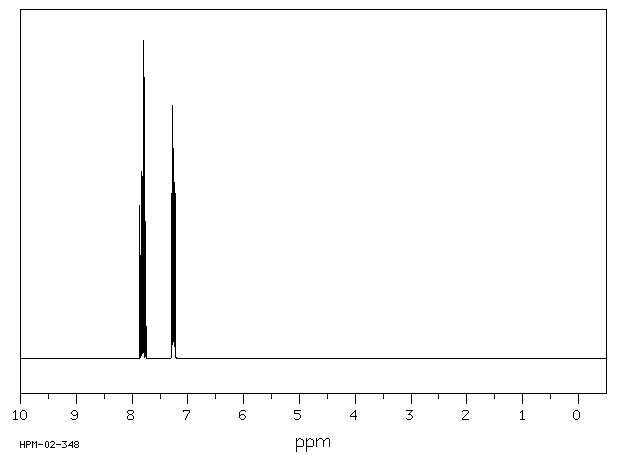tris(4-fluorophenyl)phosphine selenide | 54300-47-9
中文名称
——
中文别名
——
英文名称
tris(4-fluorophenyl)phosphine selenide
英文别名
Tris(4-fluorophenyl)-selanylidene-lambda5-phosphane;tris(4-fluorophenyl)-selanylidene-λ5-phosphane
CAS
54300-47-9
化学式
C18H12F3PSe
mdl
——
分子量
395.222
InChiKey
FYWVCSAFYSTHOG-UHFFFAOYSA-N
BEILSTEIN
——
EINECS
——
-
物化性质
-
计算性质
-
ADMET
-
安全信息
-
SDS
-
制备方法与用途
-
上下游信息
-
文献信息
-
表征谱图
-
同类化合物
-
相关功能分类
-
相关结构分类
计算性质
-
辛醇/水分配系数(LogP):3.48
-
重原子数:23
-
可旋转键数:3
-
环数:3.0
-
sp3杂化的碳原子比例:0.0
-
拓扑面积:0
-
氢给体数:0
-
氢受体数:3
上下游信息
-
上游原料
中文名称 英文名称 CAS号 化学式 分子量 三(4-氟苯基)磷化氢 P(p-C6H4F)3 18437-78-0 C18H12F3P 316.262
反应信息
-
作为反应物:描述:tris(4-fluorophenyl)phosphine selenide 、 三溴化砷 以 乙醚 为溶剂, 反应 48.0h, 以39%的产率得到Tribromoarsane;tris(4-fluorophenyl)-selanylidene-lambda5-phosphane参考文献:名称:Formation of M4Se4 cuboids (M = As, Sb, Bi) via secondary pnictogen–chalcogen interactions in the co-crystals MX3·SeP(p-FC6H4)3 (M = As, X = Br; M = Sb, X = Cl; M = Bi, X = Cl, Br)摘要:第15族三卤化物MX3(M = As, Sb, Bi;X = Cl, Br)与膦硒化物SeP(p-FC6H4)3的反应导致了化学式为MX3·SeP(p-FC6H4)3的共晶体的形成。没有观察到与MI3(M = As, Sb, Bi)的反应。已确定了MX3·SeP(p-FC6H4)3(M = As, X = Br 2;M = Sb, X = Cl 3;M = Bi, X = Cl 5;M = Bi, X = Br 6)的结构,并且它们是同构的,结晶在立方I23空间群中。所有结构都具有一个主要MX3单元,该单元通过三个次级M…Se相互作用与SeP(p-FC6H4)3分子相连。然而,每个SeP(p-FC6H4)3分子桥接三个MX3分子,从而产生了一个由氮族-硫族相互作用连接的M4Se4(M = As, Sb, Bi)扭曲立方体。立方体的四个相对角被MX3金字塔的M原子(M = As, Sb, Bi)占据,另外四个角则被膦硒化物的硒原子占据。DOI:10.1039/c2dt31010d
-
作为产物:描述:参考文献:名称:配体和酸促进剂对乙烯加氢酯化生成丙酸甲酯的影响及动力学研究摘要:开发了一种新的钯/三(4-氟苯基)膦/对甲苯磺酸催化体系,用于乙烯加氢酯化合成丙酸甲酯。系统研究了膦配体和酸促进剂对催化活性的影响。通过对硒膦化合物的31 P NMR表征,实现了膦配体的催化活性与电效应之间的火山关系。通过表征布朗斯台德酸的 p K a 值,发现有利于乙烯加氢酯化的酸强度范围。然后,膦配体/Pd(OAc) 2比例的影响,对甲苯磺酸/Pd(OAc) 2研究了该反应的比例、温度、时间和压力。最后,建立了基于基本反应的动力学模型,表明甲醇对 Pd-酰基中间体的亲核攻击生成丙酸甲酯是速率决定步骤。决速步的活化能垒为83.1 kJ·mol -1。DOI:10.1016/j.mcat.2022.112746
文献信息
-
Rapid phosphorus(<scp>iii</scp>) ligand evaluation utilising potassium selenocyanate作者:Alfred Muller、Stefanus Otto、Andreas RoodtDOI:10.1039/b712782k日期:——from 1.34 +/- 0.02 x 10(-3) to 51 +/- 3 mol(-1) dm(3) s(-1) for P(2-OMe-C(6)H(4))(3) to PCy(3) respectively. Activation parameters range from 27 +/- 1 to 49.0 +/- 1.3 kJ mol(-1) for DeltaH(double dagger) and -112 +/- 9 to -140 +/- 3 J K(-1) mol(-1) for DeltaS(double dagger) supporting a S(N)2 mechanism in which the initial nucleophilic attack of P on Se is rate determining. Reaction rates are promoted通过使用UV-Vis停止流和常规分光光度法,已在298 K的甲醇中研究了将SeCN(-)氧化加成到叔膦配体上的方法。在大多数情况下,k(obs)与[SeCN(-)]的图呈线性,截距为零,对应于k(obs)= k(1)[SeCN(-)]的速率表达式。反应速率取决于磷中心的电子密度,其中k(1)从1.34 +/- 0.02 x 10(-3)到51 +/- 3 mol(-1)dm(3)改变五个数量级。 P(2-OMe-C(6)H(4))(3)到PCy(3)的s(-1)。激活参数范围为DeltaH(双匕首)的27 +/- 1至49.0 +/- 1.3 kJ mol(-1)和-112 +/- 9至-140 +/- 3 JK(-1)mol(-1 )支持DeltaS(双匕首)的S(N)2机制,其中P对Se的初始亲核攻击是速率决定的。反应速率由更多的极性溶剂促进,以支持机理分配。在log k(1)vs之间
-
From Stable PH‐Ylides to α‐Carbanionic Phosphines as Ligands for Zwitterionic Catalysts作者:Jana‐Alina Zur、Michelle Schmidt、Kai‐Stephan Feichtner、Prakash Duari、Julian Löffler、Thorsten Scherpf、Viktoria H. GessnerDOI:10.1002/anie.202203950日期:2022.7.25PH ylides such as H2C=PH3 are considerably higher in energy than their corresponding phosphines H3C−PH2. Using bis(sulfonyl)methyl substituents, the first PH ylides stable at ambient conditions could be isolated in solution and in the solid state. They are ideal precursors to carbanionic phosphines with exclusive phosphine reactivity and thus to highly electron-rich phosphines.PH 亚烷,例如 H2C=PH3 的能量远高于其相应的膦 H3C-PH2。使用双(磺酰基)甲基取代基,可以在溶液和固态中分离在环境条件下稳定的第一个 PH ylide。它们是碳离子膦的理想前体,具有独特的膦反应性,因此是高电子富集膦的膦。
-
Malito, John; Alyea, Almer C., Phosphorus, Sulfur and Silicon and the Related Elements, 1990, vol. 54, # 1/4, p. 95 - 99作者:Malito, John、Alyea, Almer C.DOI:——日期:——
表征谱图
-
氢谱1HNMR
-
质谱MS
-
碳谱13CNMR
-
红外IR
-
拉曼Raman
-
峰位数据
-
峰位匹配
-
表征信息
同类化合物
(βS)-β-氨基-4-(4-羟基苯氧基)-3,5-二碘苯甲丙醇
(S,S)-邻甲苯基-DIPAMP
(S)-(-)-7'-〔4(S)-(苄基)恶唑-2-基]-7-二(3,5-二-叔丁基苯基)膦基-2,2',3,3'-四氢-1,1-螺二氢茚
(S)-盐酸沙丁胺醇
(S)-3-(叔丁基)-4-(2,6-二甲氧基苯基)-2,3-二氢苯并[d][1,3]氧磷杂环戊二烯
(S)-2,2'-双[双(3,5-三氟甲基苯基)膦基]-4,4',6,6'-四甲氧基联苯
(S)-1-[3,5-双(三氟甲基)苯基]-3-[1-(二甲基氨基)-3-甲基丁烷-2-基]硫脲
(R)富马酸托特罗定
(R)-(-)-盐酸尼古地平
(R)-(-)-4,12-双(二苯基膦基)[2.2]对环芳烷(1,5环辛二烯)铑(I)四氟硼酸盐
(R)-(+)-7-双(3,5-二叔丁基苯基)膦基7''-[((6-甲基吡啶-2-基甲基)氨基]-2,2'',3,3''-四氢-1,1''-螺双茚满
(R)-(+)-7-双(3,5-二叔丁基苯基)膦基7''-[(4-叔丁基吡啶-2-基甲基)氨基]-2,2'',3,3''-四氢-1,1''-螺双茚满
(R)-(+)-7-双(3,5-二叔丁基苯基)膦基7''-[(3-甲基吡啶-2-基甲基)氨基]-2,2'',3,3''-四氢-1,1''-螺双茚满
(R)-(+)-4,7-双(3,5-二-叔丁基苯基)膦基-7“-[(吡啶-2-基甲基)氨基]-2,2”,3,3'-四氢1,1'-螺二茚满
(R)-3-(叔丁基)-4-(2,6-二苯氧基苯基)-2,3-二氢苯并[d][1,3]氧杂磷杂环戊烯
(R)-2-[((二苯基膦基)甲基]吡咯烷
(R)-1-[3,5-双(三氟甲基)苯基]-3-[1-(二甲基氨基)-3-甲基丁烷-2-基]硫脲
(N-(4-甲氧基苯基)-N-甲基-3-(1-哌啶基)丙-2-烯酰胺)
(5-溴-2-羟基苯基)-4-氯苯甲酮
(5-溴-2-氯苯基)(4-羟基苯基)甲酮
(5-氧代-3-苯基-2,5-二氢-1,2,3,4-oxatriazol-3-鎓)
(4S,5R)-4-甲基-5-苯基-1,2,3-氧代噻唑烷-2,2-二氧化物-3-羧酸叔丁酯
(4S,4''S)-2,2''-亚环戊基双[4,5-二氢-4-(苯甲基)恶唑]
(4-溴苯基)-[2-氟-4-[6-[甲基(丙-2-烯基)氨基]己氧基]苯基]甲酮
(4-丁氧基苯甲基)三苯基溴化磷
(3aR,8aR)-(-)-4,4,8,8-四(3,5-二甲基苯基)四氢-2,2-二甲基-6-苯基-1,3-二氧戊环[4,5-e]二恶唑磷
(3aR,6aS)-5-氧代六氢环戊基[c]吡咯-2(1H)-羧酸酯
(2Z)-3-[[(4-氯苯基)氨基]-2-氰基丙烯酸乙酯
(2S,3S,5S)-5-(叔丁氧基甲酰氨基)-2-(N-5-噻唑基-甲氧羰基)氨基-1,6-二苯基-3-羟基己烷
(2S,2''S,3S,3''S)-3,3''-二叔丁基-4,4''-双(2,6-二甲氧基苯基)-2,2'',3,3''-四氢-2,2''-联苯并[d][1,3]氧杂磷杂戊环
(2S)-(-)-2-{[[[[3,5-双(氟代甲基)苯基]氨基]硫代甲基]氨基}-N-(二苯基甲基)-N,3,3-三甲基丁酰胺
(2S)-2-[[[[[((1S,2S)-2-氨基环己基]氨基]硫代甲基]氨基]-N-(二苯甲基)-N,3,3-三甲基丁酰胺
(2S)-2-[[[[[[((1R,2R)-2-氨基环己基]氨基]硫代甲基]氨基]-N-(二苯甲基)-N,3,3-三甲基丁酰胺
(2-硝基苯基)磷酸三酰胺
(2,6-二氯苯基)乙酰氯
(2,3-二甲氧基-5-甲基苯基)硼酸
(1S,2S,3S,5S)-5-叠氮基-3-(苯基甲氧基)-2-[(苯基甲氧基)甲基]环戊醇
(1S,2S,3R,5R)-2-(苄氧基)甲基-6-氧杂双环[3.1.0]己-3-醇
(1-(4-氟苯基)环丙基)甲胺盐酸盐
(1-(3-溴苯基)环丁基)甲胺盐酸盐
(1-(2-氯苯基)环丁基)甲胺盐酸盐
(1-(2-氟苯基)环丙基)甲胺盐酸盐
(1-(2,6-二氟苯基)环丙基)甲胺盐酸盐
(-)-去甲基西布曲明
龙蒿油
龙胆酸钠
龙胆酸叔丁酯
龙胆酸
龙胆紫-d6
龙胆紫







